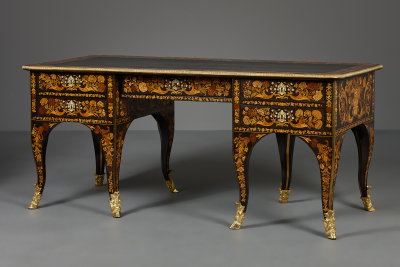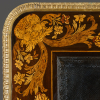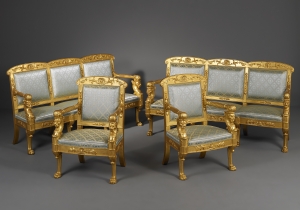French Louis XIV bureau plat, attributed to Renaud Gaudron
French Louis XIV bureau plat, attributed to Renaud Gaudron
An impressive bureau plat with rich marquetry, standing upon eight legs. The bureau comprises two drawer units, each standing upon four elegantly arched legs whose lower halves curve outwards and terminate in magnificent tall sabots of gilt bronze in the shape of goat’s feet and elegant acanthus leaves. The legs each feature a vertical brass strip on the front and back that emphasises their elegant shape and makes them appear even more slender than they already are. Between the two drawer units is a slightly recessed wide drawer. The opposite side of the desk precisely mirrors this structure, as a result of which the desk is visually identical from both sides; however, the drawers on the opposite side are false. Resting upon the drawer units is the overhanging top, comprising a large, black leather writing panel within a wide marquetry border. The top has rounded corners and is rimmed with a wide gilt bronze band that both protects and accentuates the top.
The bureau is decorated on all sides with exuberant depictions of overflowing flower baskets, surrounded by copious quantities of acanthus leaves, flowers, insects and mascarons. The result is a dense but particularly elegant composition that stands out not only due to the detailed quality of the marquetry, but also the subtle palette formed by the combination of different wood types, combining to form a powerful yet balanced and graceful whole.
Typical of high-quality furniture pieces from the latter half of the seventeenth century are the floral ensembles used in their decoration. The inlaid flowers reflect the sensibilities of a time in which flowers were greatly admired, and widely studied and collected. The technique appears to have been developed in the Dutch provinces during the first half of the seventeenth century, where it was inspired by the economic phenomenon known as the tulip mania. It appears that the technique was only introduced in Paris mid-century, when furniture maker Pierre Gole (1620-1685) moved there from the Netherlands. From 1656 onwards – the year in which Gole was appointed Maître menuisier and ébène et ordinaire du Roi – he regularly supplied furniture to important members of the court. There are beautiful pieces by his hand with floral marquetry in wood and ivory, as well as tortoiseshell and copper.
While Gole was the forerunner who paved the way for the fashion of decorative floral inlays, it was André Charles Boulle – whose family also came from the borderlands of the Netherlands and Germany – who elevated the technique to its apex one generation later. Between approximately 1675 and 1700, Boulle’s workshop developed its own unique, exuberant floral style, while the master himself found particular pleasure in decorating furniture using a combination of wood and metal inlays. Several of Boulle’s superlative pieces with floral inlays, such as the large cupboard in Saint Petersburg’s Hermitage Museum (1690-1700) and Max Emanuel of Bavaria’s famous coin cabinet in the Staatliche Münzsammlung in Munich (1690-1695), had a pronounced influence on the development of the art of furniture-making in the late seventeenth century.
Renaud Gaudron
On stylistic grounds, this bureau can be attributed to Renaud Gaudron (1653-1727). In the past, furniture pieces of such superior quality were largely attributed to André Charles Boulle or Pierre Gole. Due to the similarities between these three furniture makers, the absence of any identifying stamp on Gaudron’s works and the lack of further documentary evidence have posed a constant challenge to experts, which explains the expansion of Boulle’s and Gole’s oeuvres and the diminutive size of Gaudron’s known oeuvre. Another factor that must be taken into account is that the name Gaudron actually refers to not one but two men, namely Renaud and his father Aubertin. Father and son collaborated until Aubertin’s death, after which Renaud definitively took over the workshop’s management.
Due to a lack of information and dates with regard to the Gaudrons, the purveyor of the Garde-meuble from 1686 to 1713 is often wrongly assumed to be Aubertin Gaudron. However, closer inspection of the few dates that are known shows that it was undoubtedly Renaud Gaudron who supplied furniture to the court. Renaud was born around 1653 as the eleventh child of the Gaudron family. The birth date of his father Aubertin is unknown, but we may reasonably assume that he cannot have been much younger than 30 at the time of his eleventh child’s birth, meaning that he would have been born around 1623 at the very latest. If he had been purveyor to the court from 1686 to 1713, this would mean that he exercised that duty from age 63 to 89 at the youngest, which is highly unlikely. A single source gives the year of Aubertin Gaudron’s death as 1684, after which his son took over the management of the workshop.
As purveyor to the court, Renaud Gaudron supplied a large proportion of the furniture in the royal palaces over a period of 26 years. An extensive study by J.N. Ronfort and J.D. Augarde found that he produced 28 inlaid floral items of furniture for the Garde-meuble de la Couronne between 1686 and 1713, including tables, bureaus, commodes and gueridons. Many of the pieces by his hand have found their way to major international museums, such as the Louvre, Versailles, the Metropolitan and the Victoria & Albert.
The bureau described here stands out due to its exceptionally elegant shape and its proportions: only a handful of bureaus measuring six to seven foot in length are known to have been produced in this period.
Literature:
Pierre Ramond, Chefs d'Oeuvre des Marqueteurs, Des Origines à Louis XIV, Paris, 1994, p. 23-25
J.N. Ronfort and J.D. Augarde, Très Exceptionnel Bureau en Marqueterie de Fleurs, Paris, 9 November 1994
- Provenance
- Private collection, New York Galerie G. Sarti, London, 1994 Salomon Stodel, Amsterdam, TEFAF 1997 Private collection, Amsterdam
- Period
- ca. 1700
- Material
- walnut and softwood core veneered with rosewood, boxwood, sycamore, padauk, pearwood, satinwood, yew, bone, gilt bronze
- Dimensions
- 78.5 x 180 x 80.5 cm
Global shipping available
















